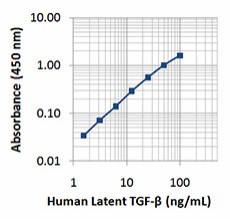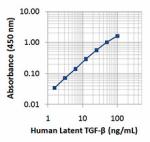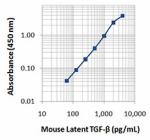- Clone
- TW7-7H4 (See other available formats)
- Regulatory Status
- RUO
- Other Names
- Latent TGF-β1, Latent TGFβ, Latent TGFβ1, LTGF-β1, LTGF-β, LTGFβ1, LTGFβ, Latent transforming growth factor beta
- Isotype
- Mouse IgG1, κ

| Cat # | Size | Price | Quantity Check Availability | ||
|---|---|---|---|---|---|
| 361203 | 100 µg | $270.00 | |||
| 361204 | 1 mg | $743.00 | |||
Select size of product is eligible for a 40% discount! Promotion valid until December 31, 2024. Exclusions apply. To view full promotion terms and conditions or to contact your local BioLegend representative to receive a quote, visit our webpage.
Latent TGF-β is secreted as a complex consisting of LAP and TGF-β1. LAP and TGF-β1 are synthesized as a single propeptide precursor of 390 amino acids with an N-terminal signal peptide of 29 amino acids, a 249 amino acids pro-region (LAP), and a 112 amino acids C-terminal region (TGF-β1).
Both LAP and TGF-β1 exist as homodimers in circulation, but the disulfide linked homodimers of LAP and TGF-β1 remain non-covalently associated, forming the small latent TGF-β complex (SLC, 100 kD). The large latent TGF-β complex (LLC, 235-260 kD) contains a third component, the latent TGF-β binding protein (LTBP), which is linked to LAP by a single disulfide bond. LTBP does not confer latency but is for efficient secretion of the complex to extracellular sites.
TGF-β1 and LAP can be released (activated) by many factors, including enzymes and low or high pH. TGF-β1 and LAP have multiple functions, such as regulating proliferation and differentiation of various cell types.
Increased production and activation of latent TGF-β have been linked to immune defects associated with malignancy and autoimmune disorders, susceptibility to opportunistic infection, and to the fibrotic complications associated with chronic inflammatory conditions.
Latent TGF-β has been found to protect against glomerulonephritis. It is also a surface marker of activated regulatory T cells.
Product Details
- Verified Reactivity
- Human, Mouse
- Antibody Type
- Monoclonal
- Host Species
- Mouse
- Immunogen
- Mouse Latent TGF-β
- Formulation
- 0.2 µm filtered in phosphate-buffered solution, pH 7.2, containing no preservative.
- Preparation
- The Ultra-LEAF™ (Low Endotoxin, Azide-Free) antibody was purified by affinity chromatography.
- Concentration
- The antibody is bottled at the concentration indicated on the vial, typically between 2 mg/mL and 3 mg/mL. Older lots may have also been bottled at 1 mg/mL. To obtain lot-specific concentration and expiration, please enter the lot number in our Certificate of Analysis online tool.
- Storage & Handling
- The antibody solution should be stored undiluted between 2°C and 8°C. This Ultra-LEAF™ solution contains no preservative; handle under aseptic conditions.
- Application
-
ELISA Capture - Quality tested
- Recommended Usage
-
Concentrations of 1 µg/mL and 0.5 µg/mL of the capture antibody were utilized to generate the example standard curves for human latent TGF-β and mouse latent TGF-β, respectively. It is recommended that each lot of reagent be titrated for optimal performance for each application.
- Application Notes
-
ELISA Capture:
To measure human latent TGF-ß, this antibody can be used as a capture antibody in sandwich ELISA format, and paired with the biotinylated TW4-6H10 antibody (Cat. No. 349707) as the detection antibody. Recombinant human latent TGF-ß (ELISA Std.) (Cat. No. 593509) can be used as the protein standard.
To measure mouse latent TGF-ß, this antibody can be used as a capture antibody in sandwich ELISA format, and paired with the biotinylated TW7-16B4 antibody (Cat. No. 141411) as the detection antibody. Recombinant mouse latent TGF-ß (ELISA Std.) (Cat. No. 594509) can be used as the protein standard.
Note: For testing human latent TGF-ß in serum, plasma or supernatant, LEGEND MAX™ Human Latent TGF-ß ELISA Kit (Cat. No. 432907) is specially developed and recommended. For testing mouse latent TGF-ß, LEGEND MAX™ Mouse Latent TGF-ß ELISA Kit (Cat. No. 433007) is recommended. - Product Citations
-
- RRID
-
AB_2888885 (BioLegend Cat. No. 361203)
AB_2888885 (BioLegend Cat. No. 361204)
Antigen Details
- Structure
- Homodimer
- Distribution
-
Latent TGF-β is secreted by numerous cells, and activated Treg cells.
- Function
- Latent TGF-β is the inactive form of TGF-β1 and LAP.
- Ligand/Receptor
- Latent TGF-β binding proteins (LTBPs)
- Cell Type
- Tregs
- Biology Area
- Apoptosis/Tumor Suppressors/Cell Death, Cell Biology, Cell Cycle/DNA Replication, Immunology
- Molecular Family
- Cytokines/Chemokines, Growth Factors
- Antigen References
-
1. Lu M, et al. 2002. J. Cell Sci. 115:4641.
2. Khalil N. 1999. Microbes. Infect. 1:1255.
3. Probst-Kepper M and Buer J. 2010. Biol. Direct 5:8.
4. Ali N, et al. 2008. PLoS One 3:e1914. - Gene ID
- 7040 View all products for this Gene ID
- UniProt
- View information about Latent TGF-beta on UniProt.org
Other Formats
View All Latent TGF-β Reagents Request Custom Conjugation| Description | Clone | Applications |
|---|---|---|
| Ultra-LEAF™ Purified anti-human/mouse Latent TGF-β | TW7-7H4 | ELISA Capture |
Compare Data Across All Formats
This data display is provided for general comparisons between formats.
Your actual data may vary due to variations in samples, target cells, instruments and their settings, staining conditions, and other factors.
If you need assistance with selecting the best format contact our expert technical support team.




